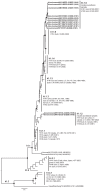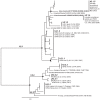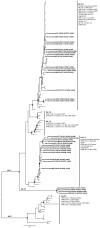Molecular surveillance of low pathogenic avian influenza viruses in wild birds across the United States: inferences from the hemagglutinin gene
- PMID: 23226543
- PMCID: PMC3514193
- DOI: 10.1371/journal.pone.0050834
Molecular surveillance of low pathogenic avian influenza viruses in wild birds across the United States: inferences from the hemagglutinin gene
Abstract
A United States interagency avian influenza surveillance plan was initiated in 2006 for early detection of highly pathogenic avian influenza viruses (HPAIV) in wild birds. The plan included a variety of wild bird sampling strategies including the testing of fecal samples from aquatic areas throughout the United States from April 2006 through December 2007. Although HPAIV was not detected through this surveillance effort we were able to obtain 759 fecal samples that were positive for low pathogenic avian influenza virus (LPAIV). We used 136 DNA sequences obtained from these samples along with samples from a public influenza sequence database for a phylogenetic assessment of hemagglutinin (HA) diversity in the United States. We analyzed sequences from all HA subtypes except H5, H7, H14 and H15 to examine genetic variation, exchange between Eurasia and North America, and geographic distribution of LPAIV in wild birds in the United States. This study confirms intercontinental exchange of some HA subtypes (including a newly documented H9 exchange event), as well as identifies subtypes that do not regularly experience intercontinental gene flow but have been circulating and evolving in North America for at least the past 20 years. These HA subtypes have high levels of genetic diversity with many lineages co-circulating within the wild birds of North America. The surveillance effort that provided these samples demonstrates that such efforts, albeit labor-intensive, provide important information about the ecology of LPAIV circulating in North America.
Conflict of interest statement
Figures














Similar articles
-
Isolation and Genetic Characterization of Avian Influenza Viruses Isolated from Wild Birds in the Azov-Black Sea Region of Ukraine (2001-2012).Avian Dis. 2016 May;60(1 Suppl):365-77. doi: 10.1637/11114-050115-Reg. Avian Dis. 2016. PMID: 27309081
-
A high diversity of Eurasian lineage low pathogenicity avian influenza A viruses circulate among wild birds sampled in Egypt.PLoS One. 2013 Jul 12;8(7):e68522. doi: 10.1371/journal.pone.0068522. Print 2013. PLoS One. 2013. PMID: 23874653 Free PMC article.
-
Wild birds in Chile Harbor diverse avian influenza A viruses.Emerg Microbes Infect. 2018 Mar 29;7(1):44. doi: 10.1038/s41426-018-0046-9. Emerg Microbes Infect. 2018. PMID: 29593259 Free PMC article.
-
The genetics of highly pathogenic avian influenza viruses of subtype H5 in Germany, 2006-2020.Transbound Emerg Dis. 2021 May;68(3):1136-1150. doi: 10.1111/tbed.13843. Epub 2020 Sep 29. Transbound Emerg Dis. 2021. PMID: 32964686 Review.
-
Surveillance for highly pathogenic avian influenza in wild birds in the USA.Integr Zool. 2009 Dec;4(4):426-39. doi: 10.1111/j.1749-4877.2009.00180.x. Integr Zool. 2009. PMID: 21392315 Review.
Cited by
-
Assessment of transmission, pathogenesis and adaptation of H2 subtype influenza viruses in ferrets.Virology. 2015 Mar;477:61-71. doi: 10.1016/j.virol.2015.01.002. Epub 2015 Feb 5. Virology. 2015. PMID: 25659818 Free PMC article.
-
Avian influenza A virus susceptibility, infection, transmission, and antibody kinetics in European starlings.PLoS Pathog. 2021 Aug 30;17(8):e1009879. doi: 10.1371/journal.ppat.1009879. eCollection 2021 Aug. PLoS Pathog. 2021. PMID: 34460868 Free PMC article.
-
Molecular Characterization of Non-H5 and Non-H7 Avian Influenza Viruses from Non-Mallard Migratory Waterbirds of the North American Flyways, 2006-2011.Pathogens. 2024 Apr 17;13(4):333. doi: 10.3390/pathogens13040333. Pathogens. 2024. PMID: 38668288 Free PMC article.
-
Monitoring of aquatic birds and surveillance of avian influenza and Newcastle disease of waterfowls at the National Park of Urmia Lake.Vet Med Sci. 2022 Sep;8(5):2016-2031. doi: 10.1002/vms3.867. Epub 2022 Jun 28. Vet Med Sci. 2022. PMID: 35763835 Free PMC article.
-
Detection of Influenza A viruses at migratory bird stopover sites in Michigan, USA.Infect Ecol Epidemiol. 2018 May 18;8(1):1474709. doi: 10.1080/20008686.2018.1474709. eCollection 2018. Infect Ecol Epidemiol. 2018. PMID: 29805786 Free PMC article.
References
-
- Stallknecht DE, Brown JD (2007) Wild birds and the epidemiology of avian influenza. J Wildlife Dis 43: S15–S20.
-
- Stallknecht DE, Shane SM (1988) Host range of avian influenza virus in free-living birds. Vet Res Commun 12: 125–141. - PubMed
Publication types
MeSH terms
Substances
LinkOut - more resources
Full Text Sources
Medical
Molecular Biology Databases
Miscellaneous

